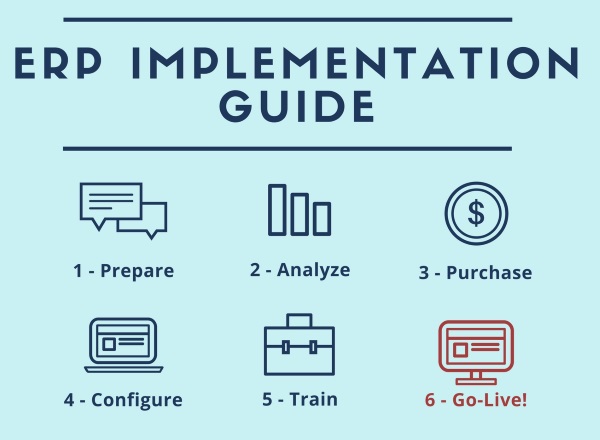Time for the ERP Deployment!
The final phase of your ERP implementation (at last!)
You’ve come a long way since the first time you’ve started talking about your new ERP.
Everything’s ready, your people are trained and the system is configured. Time to Go-Live!

Expect problems in the first days
Even if you did the best work you could, there WILL be problems in the first days.
Don’t worry, it’s perfectly normal.
Even if you have the best project manager and followed our implementation guide to the letter, you will face problems.
Some bugs will occur and employees will have many questions. If you did your job correctly, nothing major should happen, but make sure a team is on-site to help the users for the first few days.
Take every problem one by one and solve the more pressing ones first.
Detail every bugs and issues you find. Make a list, prioritize the problems and send it to the vendor. You still have the vendor’s focus, use it wisely. In a few weeks, he won’t that available and it may take much longer to get what you need.
Also note each and every little demand employees have: nice-to-have features, new report needed, etc.. Make a list for later use. You’ll use it in the second stage of the ERP implementation (you tough it was over right!?).
But do not try to address those demands right now and make it clear for everyone in the implementation team. Focus on implementing what you already have and make it work the best you can.
It won’t be perfect at first, but at least it will be functional. There will be time later to improve the system.
ERP Deployment Methodologies
There are two approaches that can be used to do the ERP Go-Live.
I personally prefer the All-in approach – where everyone starts using the system at the same time – but a step-by-step go-live process may be a good idea in some cases.
#1 – All-in approach
One of the ways of doing the ERP kick-off is to turn the switch to ON for everyone at the same time. On a Monday morning, everyone stops using their old system and start using the new ERP.
Advantages
- Quicker adoption of the system
Disadvantages
- More problems in the first days/weeks.
- Greater impact on productivity on the short-term
#2 – Step-by-step approach
The second approach is safer, but will take longer. Instead of everyone changing system at the same time, you go by department (or by process). Once the first department is implemented and fully functional, you go to the next until everyone uses the ERP system.
Advantages
- Safer approach. When something goes wrong, only a part of the business is affected
Disadvantages
- Costlier, you need to keep your implementation team around for an extended period of time.
- Takes longer
- Risks of loss of faith in the ERP. Hearing about the problems the ERP have over a few weeks may leave a bad impression in employees’ mind. Have a good communication plan and make sure that problems are resolved quickly.
- Missing data. Since everyone doesn’t start using the system at the same time, there will be a data gap.
Choosing a date for the ERP Deployment

So when do we launch the ERP? Choose a period where business is slow. Productivity will be impacted during the first weeks.
Also try to choose a period where employees are well rested, using a new system demands concentration and efforts. The return of the summer vacations is generally a good period.
After the ERP Deployment
Uninstall old systems
Once everyone uses the new ERP system, make sure you uninstall any software related to the old system. If you don’t do that, users tend to still use their old tools and that lengthens the ERP adoption.
ERP Implementation – Phase 2
Congratulations! The ERP implementation is now successful and employees have been using the system for a couple of weeks/months.
Do you want to get an even better ROI from your ERP? Time for phase #2.
By now, the ERP probably covers around 80 to 85% of the needs defined in the original business analysis. Once the ERP is functional and users are knowledgeable, try to get even more value from the ERP.
With a small team, go from department to department and ask the employees what is good and what’s not with the ERP. Also ask them what would improve their productivity.
Most of the time, the requests will be small things that can easily and quickly be delivered at a small cost (new reports, minor development, etc.). The return on investment on those requests will be very quick and this will keep your employees happy and functional.
It’s a good habit to do that every year or two. Plus, it keeps the employees in a “let’s improve the ERP” mindset.
Not only will the IT team try to get more value from the ERP, but everyone does. It’s a win-win. Employees are happier and the company is getting a better return on investment.
Home > ERP Project > ERP Deployment
